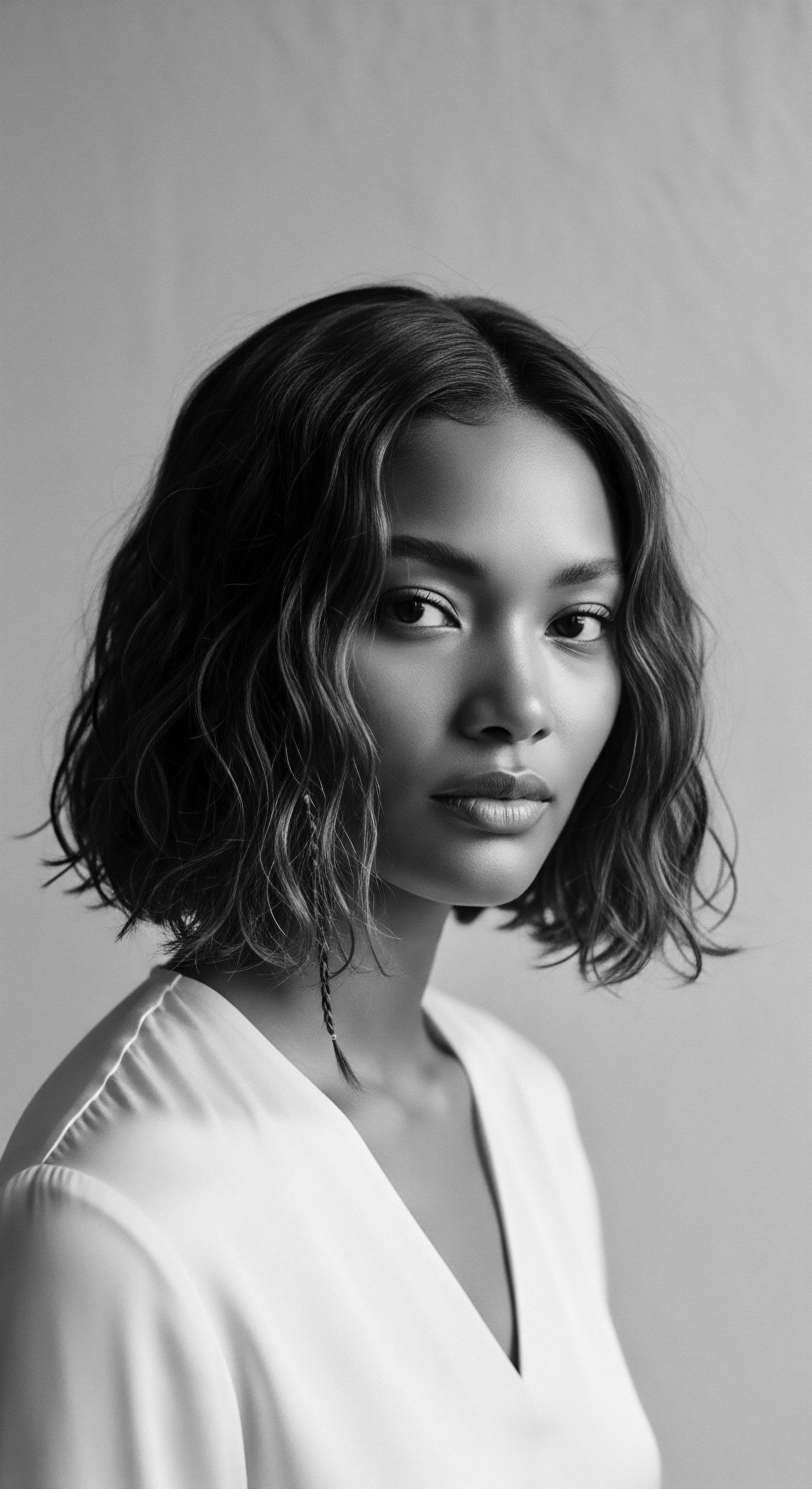
Fundamentals
The very notion of Textured Hair Behavior beckons a contemplation of the inherent tendencies and responsive inclinations woven into the very structure of coils, curls, and waves. It is an exploration of how these unique hair forms react to moisture, atmospheric shifts, and physical manipulation, shaping their visual aspect and tactile qualities. At its core, this understanding presents a nuanced explanation of hair’s living character. This is more than a simple description of appearance; it is a profound recognition of how hair, in its diverse patterns, expresses its nature.
For millennia, humanity has observed and interacted with the expressive conduct of textured hair, long before the lexicon of modern science existed. Ancient communities, particularly those of African descent, developed an intuitive knowledge of these behaviors through generations of intimate care and close observation. They understood the inclinations of coils to shrink when dry or how they softened with specific plant infusions.
This intuitive comprehension was passed down, shaping daily rituals and collective wisdom. It was a lived science, deeply connected to the Earth’s rhythms and the hair’s own subtle communications.
Textured Hair Behavior delineates the natural tendencies and dynamic responses of coiled, curly, and wavy hair to its environment and care.
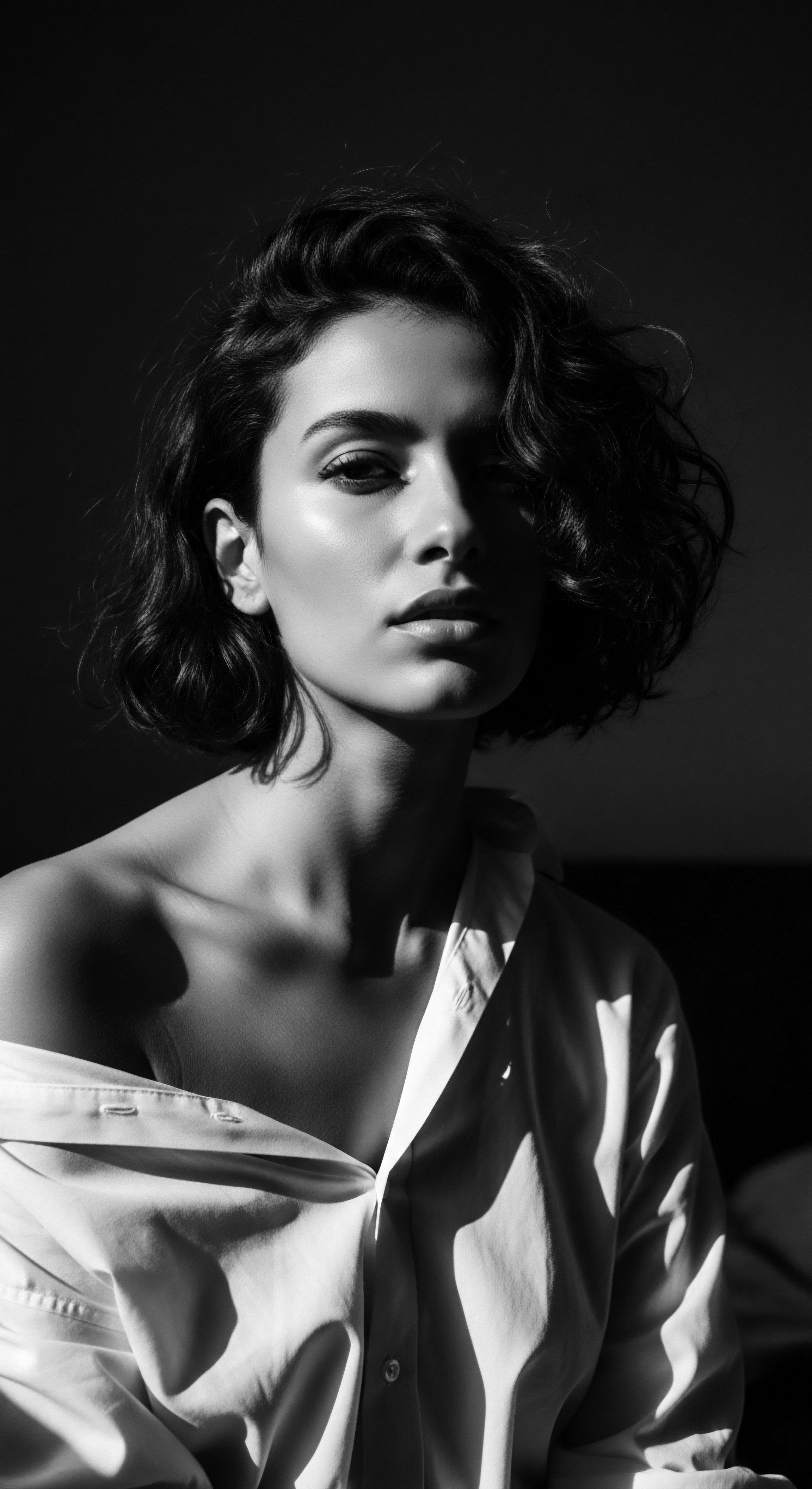
Understanding Hair’s Elemental Language
To truly grasp the foundational meaning of Textured Hair Behavior, we consider its earliest recognition. Across the African continent, before the advent of chemical alterations or even widespread commercial products, people understood that textured hair possessed a distinct responsiveness. This was observed in the way hair contracted or expanded, absorbed or repelled water, and tangled or separated depending on its condition. Such observations formed the bedrock of ancestral hair care, guiding the selection of emollients, humectants, and styling techniques.
- Coil Memory ❉ The innate tendency of hair strands to revert to their original coiled or curled formation even after being stretched or straightened. This is a fundamental aspect of its intrinsic behavior.
- Shrinkage Response ❉ The reduction in apparent length of textured hair when it dries or encounters humidity, a characteristic that often surprised those unfamiliar with its inherent properties.
- Moisture Affinity ❉ The particular way textured hair interacts with water, often requiring specific methods to absorb and retain hydration due to its structural characteristics.
This innate language of textured hair, its behavior, determined its care. If hair exhibited a tendency towards dryness, natural oils and butters were applied. If it tangled readily, intricate braiding patterns or gentle detangling with wide-toothed tools were employed.
This was not a scientific theory articulated in terms of keratin bonds, but an applied wisdom, refined over countless generations. The behavior of the hair itself was the primary guide.
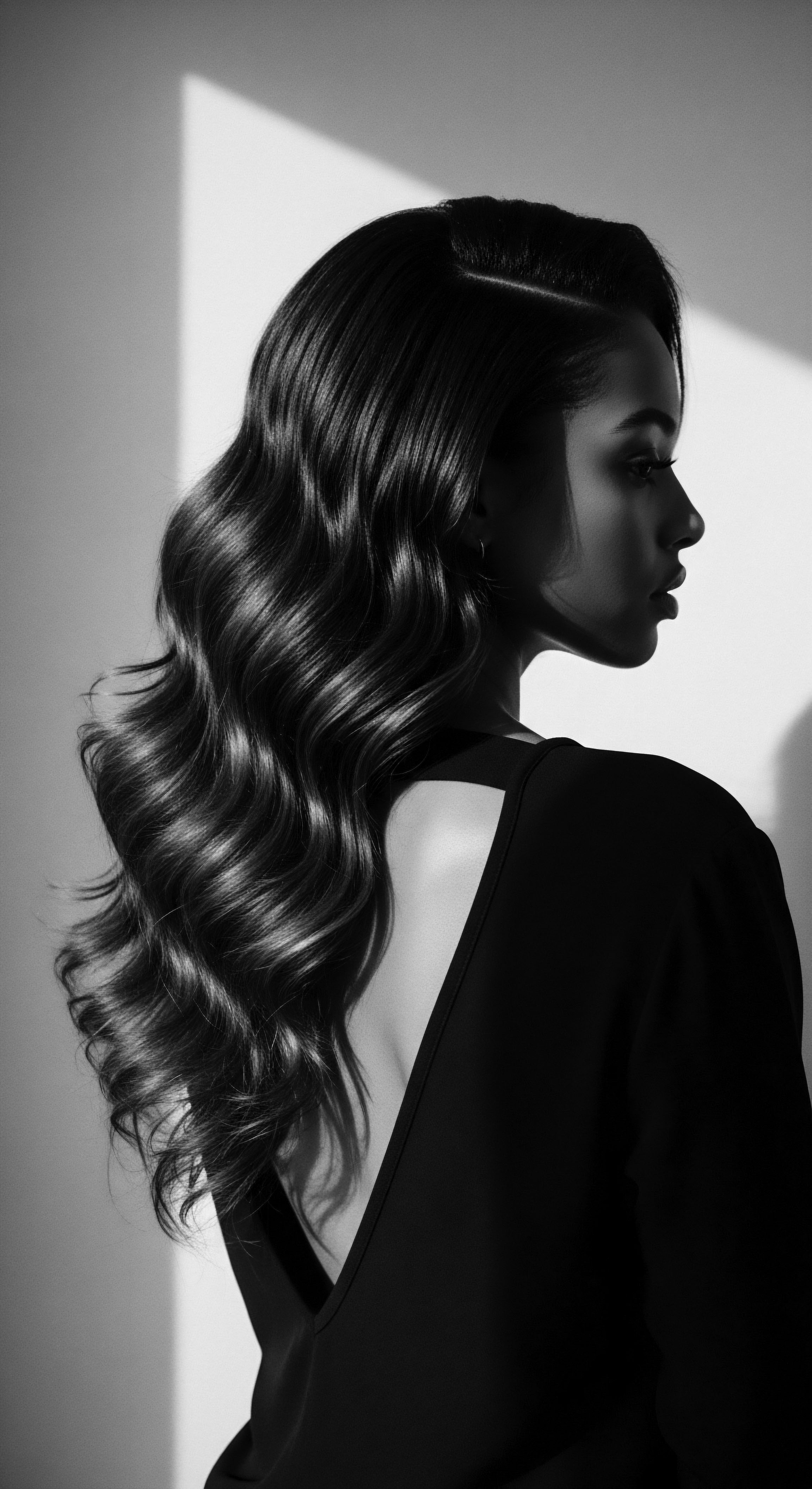
Early Practices and Hair’s Responses
The earliest forms of human adornment often involved hair, and in communities with textured hair, its unique characteristics quickly shaped practices. Hair was not merely an aesthetic canvas; it was a living fiber whose responses had to be respected. The application of shea butter or palm oil, for instance, was an acknowledgment of hair’s need for specific nourishment. The very act of sectioning and twisting, which would later evolve into intricate styles, was an intuitive response to how coiled hair strands best managed and maintained their collective integrity.
Consider the ancient practices of hair oiling found in various West African cultures. These were not random acts. They were direct responses to the observed “behavior” of textured hair – its propensity for dryness, its need for lubricity to prevent breakage, and its capacity to absorb and hold natural moisture from the environment when properly conditioned. The choice of specific plant extracts, like neem oil or chebe powder , stemmed from a deep understanding of their interactive effects with the hair’s coiled structure, a reciprocal relationship built on observation and ancestral learning.
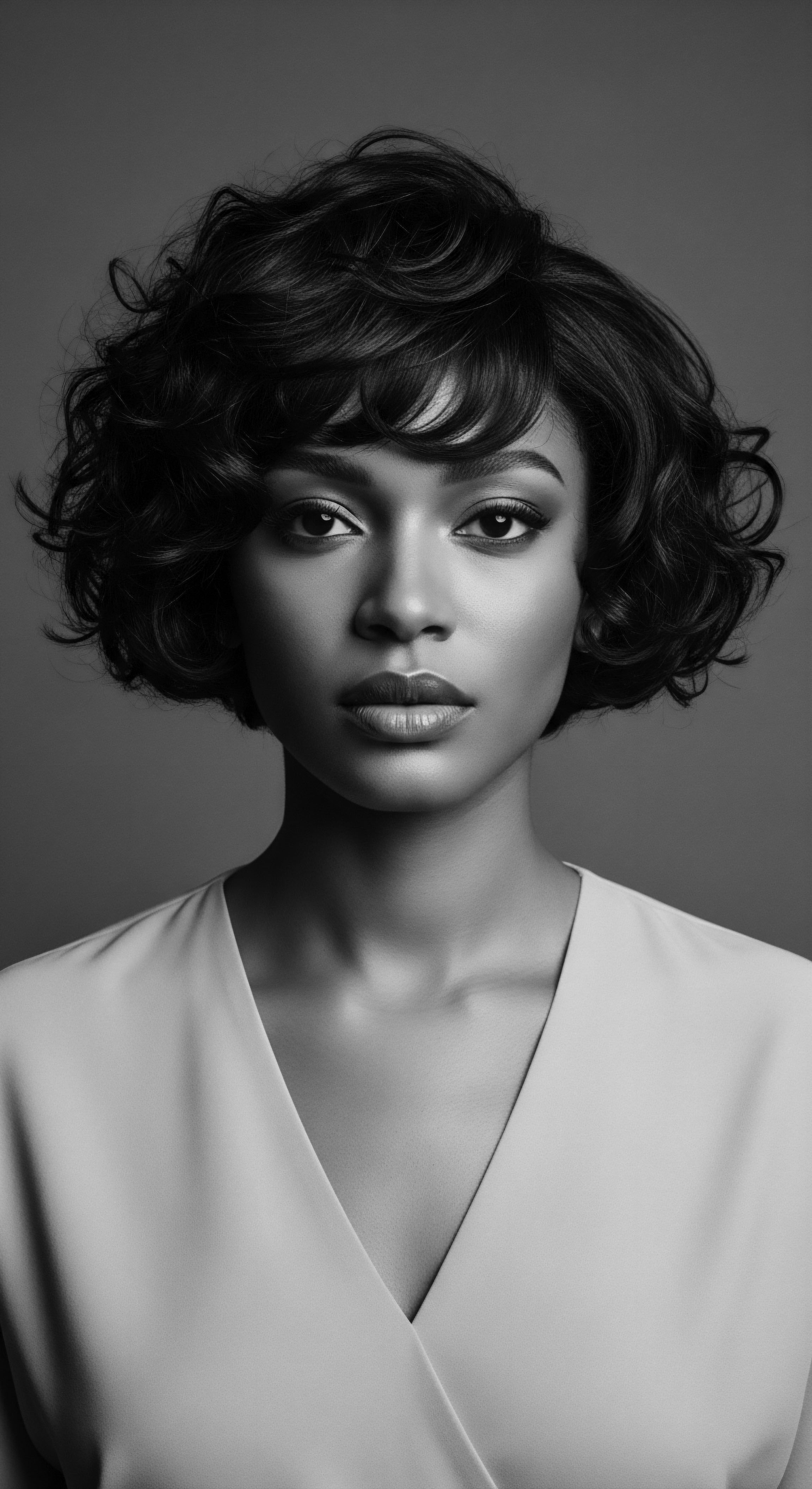
Intermediate
Moving beyond fundamental observations, an intermediate understanding of Textured Hair Behavior begins to delineate the specific mechanisms behind its characteristic actions. This involves appreciating the intricate microscopic architecture of the hair strand itself—the elliptical shape of the follicle, the uneven distribution of keratin, and the differential growth rates that contribute to its helical coiling. These biological specificities translate directly into the visible and tactile conduct of textured hair, from its capacity to shrink to its particular susceptibility to breakage when mishandled.
The historical trajectory of hair care in Black and mixed-race communities often mirrored a collective, evolving understanding of these inherent behaviors. As knowledge accumulated and traditions deepened, so too did the sophistication of care rituals. Hair was recognized as a barometer of health and a vessel of cultural significance. The way hair responded to its environment—becoming brittle in arid climates or losing definition in high humidity—informed the adaptive strategies developed by ancestral practitioners.
The intricate biology of textured hair’s structure directly influences its observable behaviors, informing culturally responsive care practices throughout history.
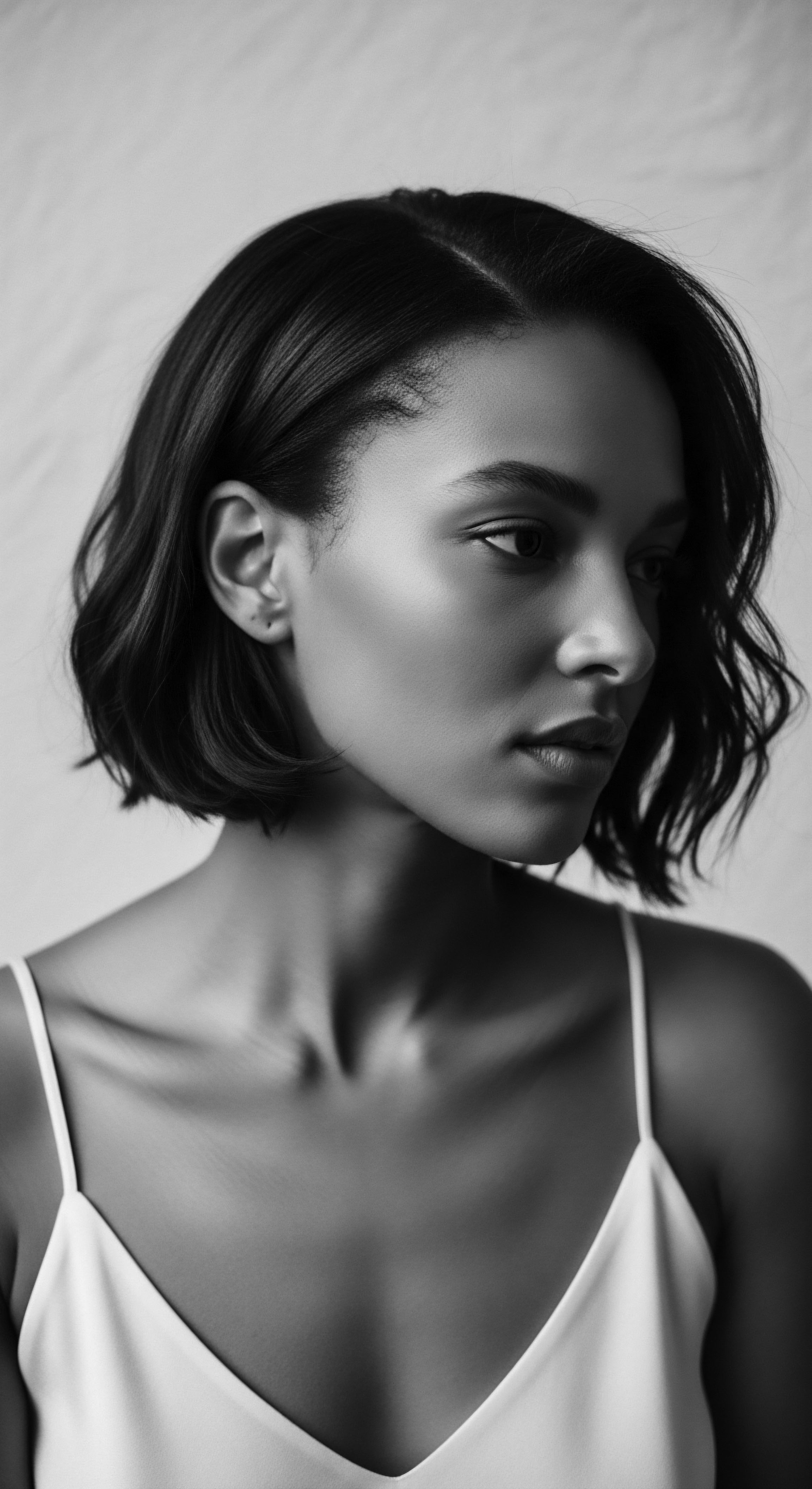
The Unseen Architecture of Behavior
The unique configurations of textured hair are not arbitrary; they are determined at the follicular level. A straight hair strand emerges from a round follicle, while a highly coiled strand typically originates from a more elliptical, sometimes kidney-shaped, follicle. This shape dictates the angle at which the hair grows and the way the keratin proteins within the strand arrange themselves.
The inner cortex of textured hair strands often exhibits an asymmetric distribution of different keratin types, which causes tension and twisting as the hair grows, leading to its characteristic curl. This intrinsic structural asymmetry is a primary determinant of its outward behavior.
When we consider the behavior of ‘clumping’ in wet textured hair, for instance, we are observing the natural tendency of individual strands, influenced by their elliptical cross-section and the presence of certain bonds, to align and aggregate. This clumping facilitates detangling and defines curl patterns, a characteristic often leveraged in styling. Similarly, the unique cuticle structure of textured hair, with its often raised or more open scales, impacts its moisture retention capabilities. This particularity explains why many ancestral care practices focused so heavily on sealing moisture into the hair shaft.

Hair’s Responses and Evolving Care Traditions
The historical adaptation of hair care practices is a testament to observing Textured Hair Behavior. For generations, traditional African hair specialists studied hair’s reaction to different elements. They understood that hair prone to knotting required patience and a methodical approach. The development of specialized combs from natural materials or the use of fingers to separate strands individually speaks to this refined awareness.
In communities across the African diaspora, the journey of understanding Textured Hair Behavior took on new dimensions, influenced by migration, climate, and often, by forced adaptation. The resilience of hair, its ability to withstand constant manipulation, and its capacity to hold complex styles became not only a matter of beauty but also of identity and communication.
Consider the historical use of specific plants in traditional African hair care, often passed down orally through generations. These plants were chosen for their direct observable impact on hair behavior.
| Traditional Ingredient Chebe Powder (from Chad) |
| Ancestral Observation (Behavior Addressed) Reduces breakage, promotes length retention by keeping hair strands strong and moisturized, addressing fragility. |
| Modern Understanding (Mechanism of Action) Contains saponins and emollients that strengthen the hair shaft, reducing friction and preventing tangles, thus minimizing mechanical stress on fragile coils. |
| Traditional Ingredient Shea Butter (West Africa) |
| Ancestral Observation (Behavior Addressed) Softens hair, adds luster, provides slip for detangling, addresses dryness and stiffness. |
| Modern Understanding (Mechanism of Action) Rich in fatty acids and vitamins, it forms a protective barrier on the hair shaft, reducing water loss and increasing flexibility, easing manipulation. |
| Traditional Ingredient Aloe Vera (various regions) |
| Ancestral Observation (Behavior Addressed) Soothes scalp, provides hydration, detangles, addresses scalp irritation and dryness. |
| Modern Understanding (Mechanism of Action) Enzymes and polysaccharides hydrate the hair and scalp, while its slippery consistency aids in detangling, reducing stress on fragile strands. |
| Traditional Ingredient Baobab Oil (Southern/Eastern Africa) |
| Ancestral Observation (Behavior Addressed) Nourishes dry hair, improves elasticity, addresses brittleness and lack of suppleness. |
| Modern Understanding (Mechanism of Action) Contains omega fatty acids and vitamins that penetrate the hair shaft, improving internal strength and flexibility, making hair less prone to breakage. |
| Traditional Ingredient These ancestral insights into hair behavior, gleaned from generations of observation, form the bedrock of culturally informed hair wellness today. |
The intimate relationship between care practices and the observed tendencies of textured hair created a cyclical wisdom. Each action—from the rhythmic application of specific concoctions to the precise execution of protective styles—was a dialogue with the hair, responding to its innate language and guiding its expression. This deep attention to the hair’s communicative responses allowed for the continuity of vibrant hair traditions even amidst immense societal change.

Academic
Textured Hair Behavior, from an academic and scientific perspective, denotes the quantifiable and qualitative attributes of coiled, curly, and wavy hair, particularly in its responsiveness to internal biological factors and external environmental stimuli. This encompassing interpretation considers not only the biophysical mechanics of the hair strand—its unique elliptical cross-section, its varying diameter along the length, and the asymmetric distribution of keratin proteins within the cortex—but also the complex interplay of these characteristics with moisture, tension, friction, and chemical agents. The academic delineation expands to include the historical, sociological, and psychological ramifications of these hair characteristics within cultural contexts, especially for individuals of Black and mixed-race heritage, where hair has long been a potent symbol of identity, resistance, and communal ties. This exploration requires examining the precise mechanisms by which hair contracts, expands, forms defined clusters, and reacts to manipulation, all while situating these observations within the broader human experience.
The precise morphology of textured hair follicles, often exhibiting a pronounced curvature and an asymmetrical opening to the scalp, dictates the initial growth pattern. This curvature, combined with the differential rates of cell proliferation on opposing sides of the follicle, leads to the characteristic helical twist of the hair shaft. At the molecular level, distinct types of keratin intermediate filaments (KIFs) and keratin-associated proteins (KAPs) are distributed unevenly across the cortex, creating regions of differing tensile strength and elasticity.
These subtle asymmetries contribute significantly to the hair’s propensity for coiling, its capacity for shrinkage, and its unique mechanical properties such as elasticity and torsional rigidity. The academic lens examines how these foundational biophysical properties, when subjected to hygroscopic changes (water absorption and desorption), lead to observable phenomena like extreme shrinkage or the formation of distinct curl clumps, phenomena often misunderstood or miscategorized in historical dermatological literature.
Textured Hair Behavior, academically considered, refers to the measurable biophysical responses of coiled hair strands shaped by their unique follicle and protein structures, with profound historical and cultural implications.
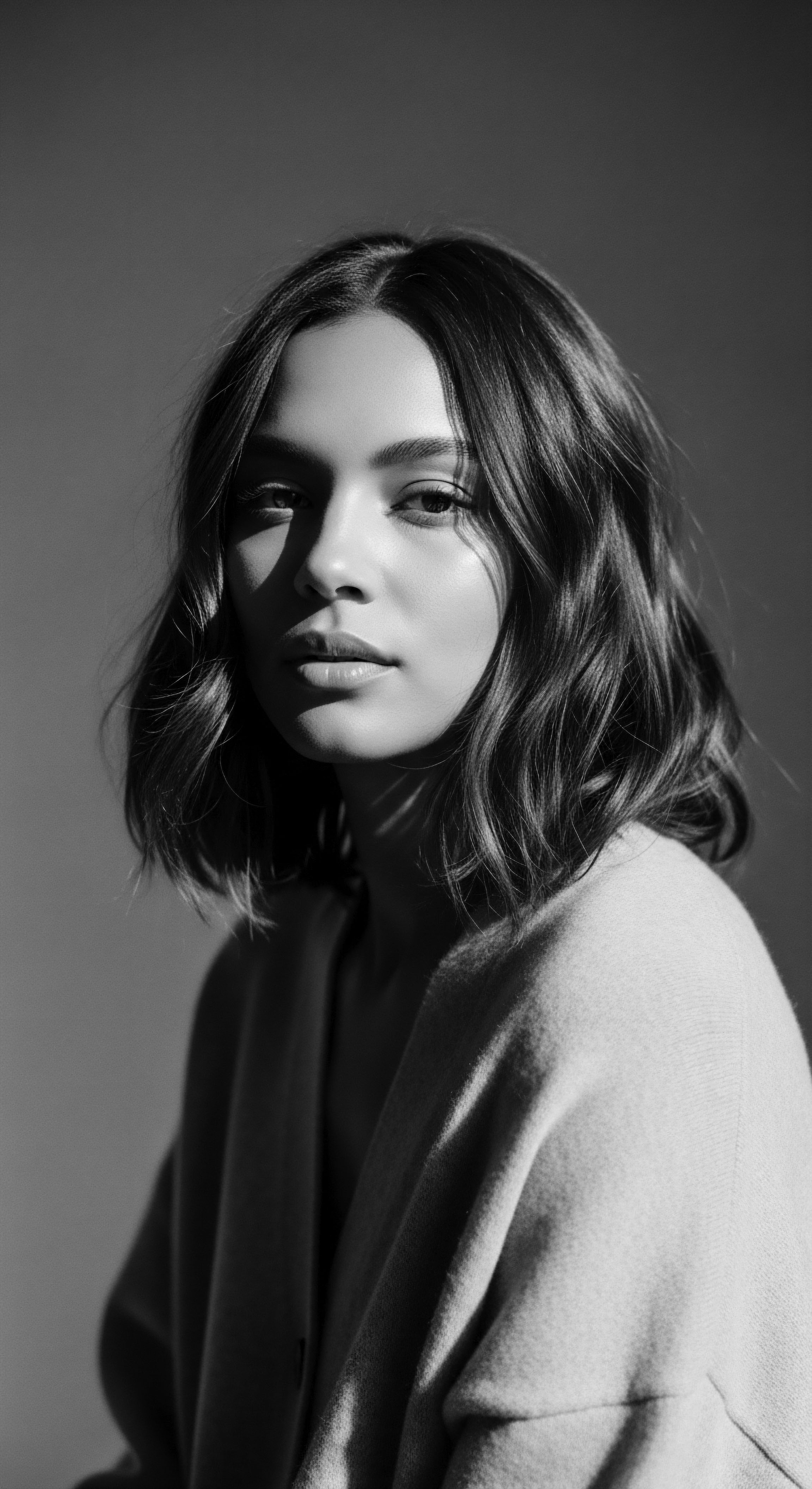
Echoes from the Source ❉ Biophysical Underpinnings
The scientific community’s systematic examination of Textured Hair Behavior began to gain momentum as analytical tools became more sophisticated. Early microscopic studies, though rudimentary, hinted at the unique structural differences of textured hair compared to straight hair. Modern analysis, employing techniques such as scanning electron microscopy and atomic force microscopy, has revealed the intricate details of the cuticle layer, which, in textured hair, tends to have more uplifted scales than in straight hair. This particular cuticle arrangement influences friction between strands, contributing to tangling and potentially affecting the speed of water absorption and loss.
Furthermore, the presence of disulfide bonds, hydrogen bonds, and salt linkages within the keratin structure play a critical role in maintaining the hair’s coiled form. These bonds are highly susceptible to environmental changes, particularly humidity, which affects hydrogen bonds, leading to the temporary alteration of curl patterns, a phenomenon commonly experienced as ‘frizz.’
Understanding the precise mechanics of shrinkage provides a compelling case study of Textured Hair Behavior. Hair shrinkage, the reduction in apparent length of textured hair when transitioning from a wet, elongated state to a dry, contracted state, is a direct consequence of the hair’s unique helical conformation. When wet, water molecules penetrate the hair shaft, disrupting some of the hydrogen bonds and causing the keratin proteins to swell and relax, allowing the hair to elongate. As the hair dries, water evaporates, and the hydrogen bonds reform, pulling the coils back into their tighter, natural configuration.
This can result in a significant perceived loss of length, often 50% or more, particularly in highly coiled hair types. This fundamental biophysical response has had considerable sociological repercussions, contributing to historical perceptions of textured hair as ‘unruly’ or ‘difficult’ in contexts that valued length and straightness, thereby reinforcing the imperative for chemical alteration.

The Tender Thread ❉ Ancestral Wisdom and Hair as Cultural Repository
The lived experiences of textured hair communities offer a compelling counter-narrative to purely scientific or often pathologizing interpretations. For generations, ancestral practices honed a profound, embodied understanding of Textured Hair Behavior. This was not a detached observation but an intimate, almost spiritual connection, where hair was recognized as a conduit to heritage, spirituality, and identity. The understanding of how hair behaved—how it held moisture, how it responded to braiding, how it could be styled to convey meaning—was essential for cultural continuity and communal flourishing.
One powerful historical example that profoundly illuminates the connection between Textured Hair Behavior, ancestral practices, and the Black hair experience is the documented use of intricate braiding patterns among the Mende Women of Sierra Leone during the transatlantic slave trade. This practice, deeply rooted in ancestral hair artistry, transcended mere aesthetics; it transformed hair into a clandestine vessel of survival. Before being forcibly removed from their homelands, Mende women would meticulously braid rice seeds, grain, or even small gold nuggets into their tightly coiled hair. These elaborate styles, often resembling cornrows, were more than adornments; they served as living maps, indicators of tribal affiliation, and crucially, as repositories for life-sustaining resources that would be essential for survival and planting in unfamiliar new lands.
This act of braiding demonstrates an intimate, practical comprehension of Textured Hair Behavior. The hair’s natural capacity to be tightly woven, its inherent resilience to hold a form under tension, and its ability to conceal small objects within its compact coils were all leveraged for a desperate, yet ultimately successful, act of resistance and preservation (Byrd & Tharps, 2001).
This historical incident exemplifies how the observable characteristics of textured hair – its robust structure, its ability to hold a style firmly for extended periods, and its density – were not just biological facts but were culturally understood and strategically employed. The very ‘behavior’ of the hair to accept and retain these intricate patterns meant survival. This ancestral knowledge, rooted in meticulous observation and intergenerational transmission, showcases a deep appreciation for the hair’s properties, recognizing its protective qualities and symbolic significance far beyond superficial appearance. It speaks to hair as a living archive, a repository of history and hope, capable of securing not just seeds, but the seeds of a future in a land far from home.

The Unbound Helix ❉ Sociocultural Implications and Future Directions
The academic investigation of Textured Hair Behavior also spans its profound sociocultural implications. Historically, dominant beauty standards, often rooted in European aesthetics, marginalized textured hair, labeling its natural behaviors (like shrinkage or frizz) as undesirable. This societal pressure led to widespread practices of chemical straightening and heat manipulation, often causing significant damage to the hair and, by extension, to the self-perception of individuals with textured hair. The persistent societal scrutiny of natural textured hair has been linked to various psychological impacts, including issues of self-esteem and identity affirmation, particularly in professional and educational settings.
However, a contemporary academic shift recognizes the importance of understanding and affirming Textured Hair Behavior. This involves not only scientific research into optimal care practices that honor the hair’s natural inclinations but also sociological studies on the ‘natural hair movement’ and its role in challenging oppressive beauty norms. This movement, built on a foundation of reclaiming ancestral practices and celebrating inherent hair characteristics, actively redefines the meaning of ‘manageable’ and ‘beautiful’ hair. Academic discourse now frequently examines the intersection of hair texture, race, gender, and socio-economic status, exploring how the acceptance or rejection of natural hair behavior affects individual and collective well-being.
Future directions in the academic understanding of Textured Hair Behavior involve multidisciplinary approaches. Material science seeks to develop products that work in harmony with the hair’s inherent properties, rather than against them, focusing on maintaining the integrity of the keratin structure and optimizing moisture balance to support natural coiling and reduce breakage. Public health research examines the long-term health consequences of chemical relaxers and heat styling, prompting a re-evaluation of historical hair care practices.
Simultaneously, cultural studies continue to document and analyze the diverse ways textured hair communicates identity, social status, and ancestral ties across global diasporas. The profound significance of Textured Hair Behavior extends beyond biophysics; it speaks to the very fabric of identity and the enduring power of heritage.
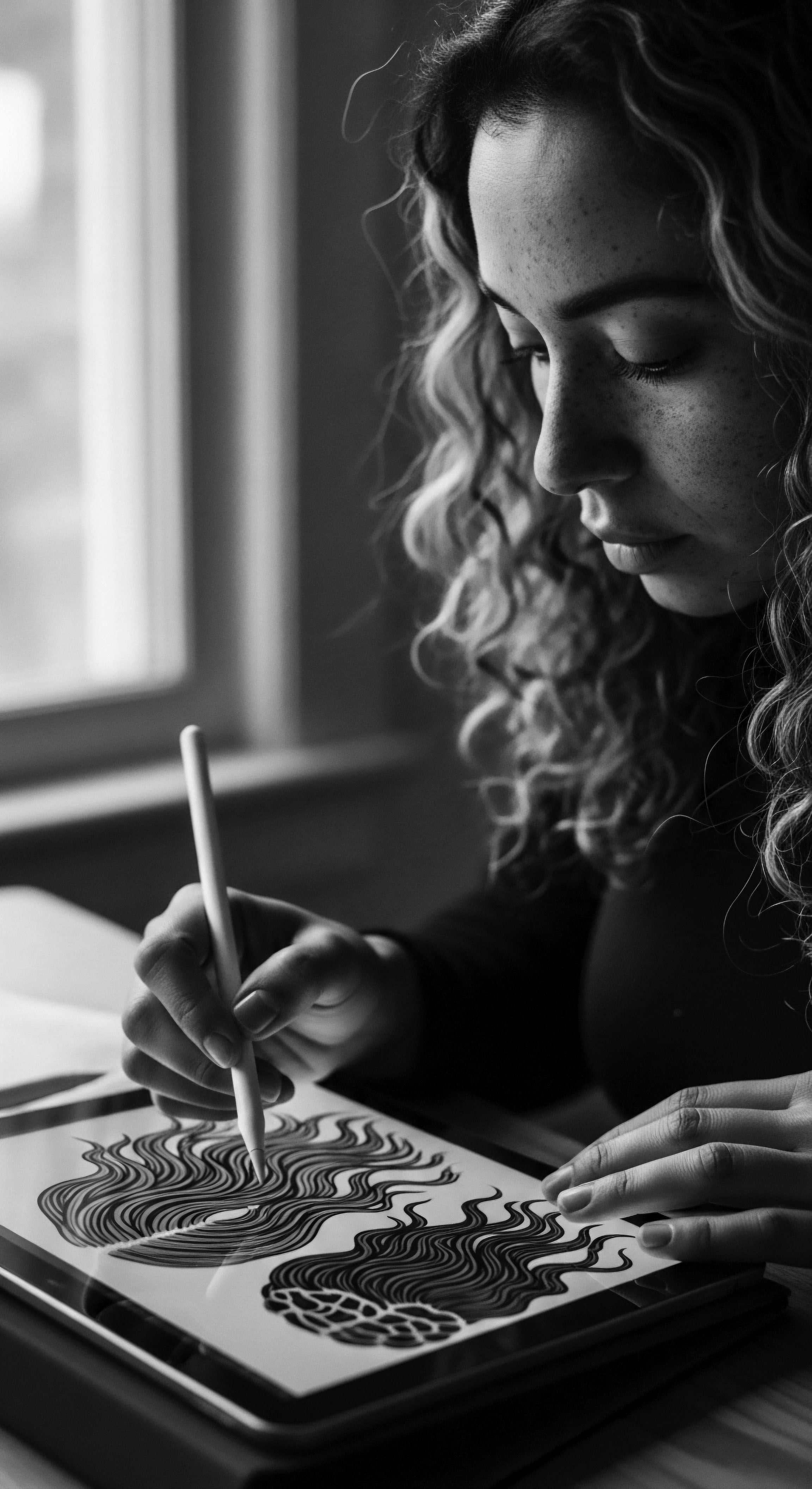
Reflection on the Heritage of Textured Hair Behavior
To meditate upon Textured Hair Behavior is to engage in a profound dialogue with time itself, reaching back through generational memory and forward into an unbound future. It is to acknowledge that every coil, every wave, carries within its very structure the echoes of ancestral resilience and ingenuity. The responsiveness of hair, its inclination to spring back, to absorb life-giving moisture, to hold the shape of wisdom, speaks to a continuity of care that transcends centuries.
For our foremothers and forefathers, understanding the living essence of hair was not merely practical; it was a sacred endeavor. They understood that hair’s unique conduct was a gift, a connection to the earth and to spirit. This profound recognition of hair’s inherent characteristics meant developing practices that worked with, rather than against, its nature.
Their methods of deep conditioning, protective styling, and gentle detangling were born from an intuitive awareness of how hair behaves, a deep reverence for its delicate yet strong qualities. This legacy of care, passed down through quiet wisdom and practiced hands, remains a guiding light.
In every strand, then, lies a testament to heritage—a story of adaptation, survival, and the persistent flourishing of identity. The way textured hair expresses itself in the world, its ‘behavior,’ remains a potent symbol of self-acceptance and a vibrant connection to a rich, enduring past.

References
- Byrd, A. D. & Tharps, L. L. (2001). Hair Story ❉ Untangling the Roots of Black Hair in America. St. Martin’s Press.
- Gubelin, A. (1998). The Science of Hair Care. CRC Press.
- Robbins, C. R. (2012). Chemical and Physical Behavior of Human Hair. Springer.
- Powell, K. & Tarver, J. (2017). African American Hair ❉ An Ethnographic Perspective. Lexington Books.
- Banks, I. (2000). Hair ❉ A Cultural History. Rizzoli.
- Hunter, M. (2011). Buying Hair ❉ The True Story of How Human Hair is Becoming a Commodity. Palgrave Macmillan.
- Mercer, K. (1994). Welcome to the Jungle ❉ New Positions in Black Cultural Studies. Routledge.
- Weiner, S. A. & Rogers, G. E. (2013). Keratin ❉ Proteins, Structure, and Applications. Nova Science Publishers.
- Synnott, A. (1987). Shame and Glory ❉ A Sociology of Hair. The British Journal of Sociology, 38(3), 381-413.
